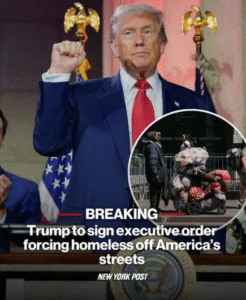Trump Signs Executive Order Forcing Homeless Off America’s Streets
In a move that has sparked immediate nationwide debate, former President Donald Trump has signed a controversial executive order mandating the removal of homeless individuals from public streets across the United States. The order, framed as part of a broader initiative to restore “law, order, and dignity” to American cities, outlines a federal plan to clear homeless encampments and relocate unsheltered people into designated facilities.
According to the order, city and state officials will be required to enforce strict anti-camping regulations, effectively banning the presence of homeless populations in parks, sidewalks, transit stations, and other public spaces. Federal support will be provided in the form of funding, logistics, and infrastructure development for temporary housing centers—though critics argue that these facilities resemble detention-style compounds rather than comprehensive shelters.
Trump, speaking at the signing, said: “We can no longer allow our beautiful cities to be taken over by tents, drugs, and danger. This is not compassionate—it is chaos. We are doing what no one else has had the courage to do. We’re giving our cities back to the people who love and care for them.”
He added that the streets of cities like Los Angeles, San Francisco, Portland, and New York have become “unlivable and unsafe,” blaming weak leadership, progressive policies, and a lack of enforcement. The executive order gives the Department of Housing and Urban Development (HUD) and the Department of Justice expanded authority to coordinate with local governments, police departments, and national guard units where necessary.
Under the directive, federal agencies are tasked with identifying “high-priority zones” for cleanup and enforcement. These zones include areas with large encampments, high crime rates, and significant complaints from businesses and residents. The order emphasizes a “zero-tolerance approach” for illegal camping, loitering, or public drug use.
The initiative also includes the construction of “transitional housing centers,” which Trump described as “safe, clean, and structured.” These centers, however, will operate under strict rules, curfews, and behavioral requirements. Individuals who refuse to comply or relocate may face legal consequences, including fines or jail time.
Civil rights groups and homelessness advocates have condemned the order as cruel and unconstitutional. Many warn that it criminalizes poverty and further marginalizes people who are already vulnerable. “This is not a solution—it’s a sweep,” said one national homelessness advocate. “It’s a forced relocation program that ignores the root causes of homelessness—mental illness, addiction, poverty, and lack of affordable housing.”
Cities already struggling with homelessness now face the difficult task of complying with federal mandates while balancing local policies and humanitarian concerns. Some mayors have expressed concern about the lack of funding or long-term planning attached to the order. Others have questioned whether the approach will simply push homelessness out of sight without addressing the core issues.
Legal experts are also examining the constitutionality of the executive order. Questions are being raised about whether the directive violates individuals’ rights under the Fourth and Eighth Amendments, which protect against unreasonable searches and cruel and unusual punishment. Lawsuits are expected.
Despite the backlash, supporters of the order claim it is a necessary step to restore urban safety and quality of life. Some business owners and residents in affected areas say that past efforts to manage homelessness have failed, leaving communities unsafe and unhygienic. “We’ve waited for years for action,” one downtown Los Angeles business owner said. “Now something is finally being done.”
The executive order comes as homelessness continues to rise in several major American cities. Economic instability, rising housing costs, and the ongoing mental health crisis have all contributed to an increase in people living unsheltered. The Biden administration had previously pushed for housing-first solutions, but Trump’s approach prioritizes enforcement and containment.
This bold, sweeping order reflects Trump’s campaign-era rhetoric, promising tough action and the reclaiming of American cities. Whether it will lead to meaningful change—or provoke further division—remains to be seen. For now, it sets the stage for a tense clash between federal power, local autonomy, and civil liberties.


